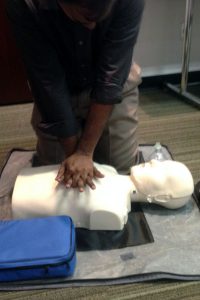 NEW ORLEANS — CPR increases the chance of survival after sudden cardiac arrest, yet knowledge of this life-saving procedure is low in many communities, especially among older adults, according to separate studies presented during the Resuscitation Science Symposium at the American Heart Association’s Scientific Sessions 2016.
NEW ORLEANS — CPR increases the chance of survival after sudden cardiac arrest, yet knowledge of this life-saving procedure is low in many communities, especially among older adults, according to separate studies presented during the Resuscitation Science Symposium at the American Heart Association’s Scientific Sessions 2016.
In two studies – one in the United States and the other in Denmark – older adults emerged as an overlooked demographic and a target area for improved CPR training. Immediate CPR can double or triple chances of survival after sudden cardiac arrest.
In the American study (Presentation18), a random digit dial telephone survey of 9,022 respondents age 18 and older found that only 18 percent reported that they were currently trained in CPR delivery – via either conventional CPR or chest compression-only approaches. About 65 percent said they had received CPR training at some point.
According to the survey:
- Higher education level was linked with a 43 percent increased likelihood of ever being CPR-trained.
- Higher household income was l with a 7 percent increased likelihood of ever being CPR-trained.
- Compared to younger adults, those age 50 and older were 50 percent less likely to be CPR trained.
- In fact, there was a steep drop in the likelihood of having CPR training after age 50.
“Cardiac arrest occurs among people in their 50s and 60s, and most cardiac arrests occur in the home, yet that is the population that is poorly trained or has not kept up with current training,” said Benjamin Abella, M.D., M.Phil., senior study author and director of the University of Penn’s Center for Resuscitation Science and an associated professor of Emergency Medicine in the Perelman School of Medicine in Philadelphia.
“If we expect one of the key links in the chain of survival to be the bystander response, including the use of automatic external defibrillators and the delivery of CPR, then we really need to better understand what gets bystanders to act, what gets bystanders to learn and refresh their CPR skills and the current ways to seek training in any given community,” he said.
In the Denmark analysis (Presentation 229), 99 questionnaire responses from adults over 65 years old, found reluctance among the elderly to perform CPR. The biggest barriers were lack of knowledge and a fear of doing harm to the person under cardiac arrest.
If they witnessed a cardiac arrest:
- 85 percent of respondents said they would be willing to call the Emergency Medical Services (EMS);
- 35 percent would provide rescue breaths;
- 36 percent would give chest compressions;
- 35 percent would use an automated external defibrillator (AED); and
- only 15 percent said that they would be willing to do all of the above.
“We do believe there needs to be a special focus on the elderly,” said Lise Qvirin Krogh, lead study author and research fellow at Arhus University Hospital’s Research Center for Emergency Medicine in Denmark. “Calling the EMS is a very big step in the right direction, but they can help the victim much more by also starting CPR.”
The study sample was small and the data was collected from members of leisure clubs who may be more active than the general elderly population, Krogh said. But the research is a start in identifying areas to improve the quality of bystander delivery of CPR among elderly.
“It was surprising that among these respondents it was only about 35 percent who would actually start CPR,” she said. “The willingness to perform CPR is very dependent on the knowledge about CPR. With this study we can get closer to strategies to increase the knowledge about CPR and focus CPR training among the elderly.”




